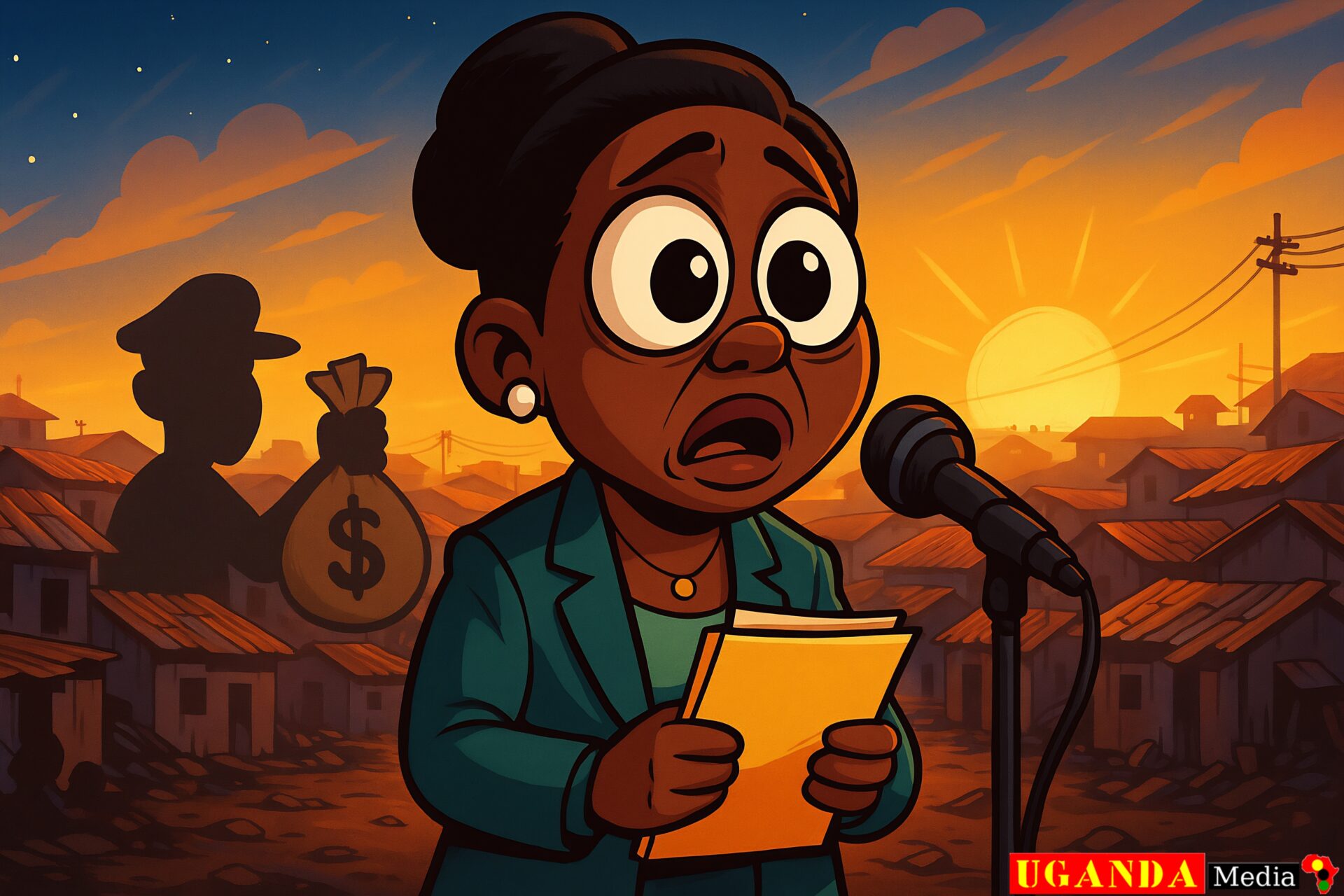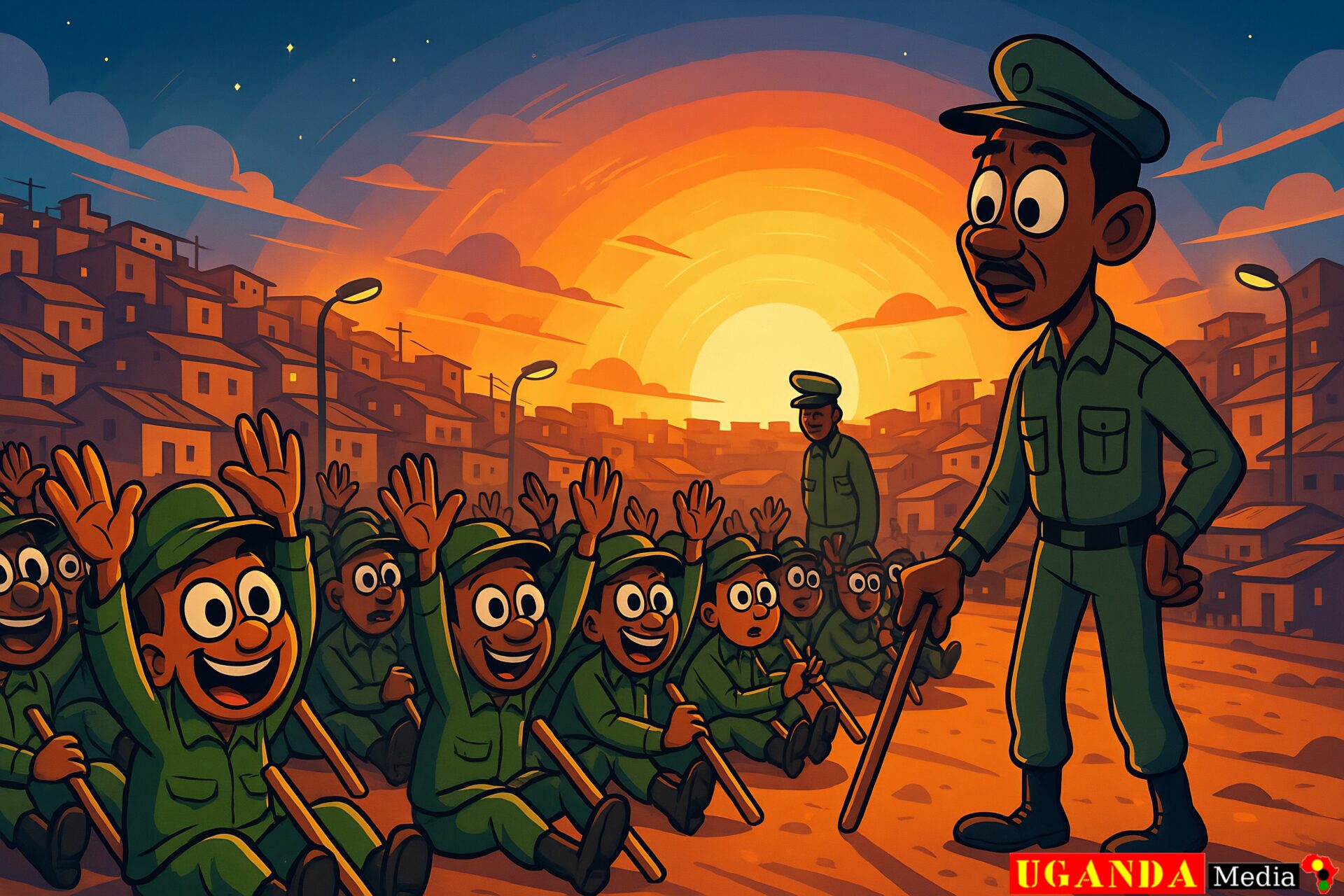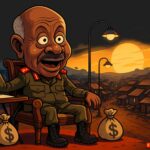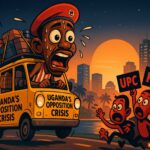From Tunguka to Oba: Museveni’s Blueprint for Prosperity and the Politics of Patriotism
In a recent address to patriotism club graduates in Uganda, President Yoweri Museveni laid out a compelling yet deeply contentious vision for the nation’s future. This speech, a masterclass in political rhetoric, wove together grand economic theory, the ideology of the National Resistance Movement (NRM), and immediate tangible rewards. At its heart lies a radical proposition: that patriotism is not an emotional attachment but a pragmatic economic necessity. The President argued that loving Uganda is rational because a stable and prosperous Uganda is every citizen’s best customer.
This philosophy is built on the dual pillars of Tunguka (public development like roads and schools) and Oba (private household wealth). Museveni prescribed a state-directed path to prosperity through Four Pillars: Commercial Agriculture, Manufacturing/Artisanship, Services, and ICT. He showcased billion-shilling farmers as proof of concept and promised future rewards for those who wait patiently within this system.
Yet, a critical analysis reveals a profound paradox. Can a philosophy of self-reliant wealth creation truly coexist with a political culture of top-down patronage? This article offers a radical deconstruction of this vision. We examine the calculated prioritisation of scientists over arts teachers, the theatrical fight against corruption, and the strategic use of financial gifts to reinforce dependency. We argue that the state’s model, while promising liberation through wealth, often deliberately engineers inequality and neutralises dissent. This is not merely an economic policy; it is a sophisticated blueprint for maintaining power, challenging us to question the very nature of development, patriotism, and freedom in modern Uganda.

20 Key Points and Arguments Explored :
The Gardeners of the New Consciousness: Ideology and the Patriotism Club Graduation
The scene is meticulously set. Under the unwavering sun, rows of teachers sit in attentive lines, the bright kits of their uniforms a stark contrast to the deep green of the parade grounds. This is no ordinary graduation. It is a passing-out ceremony for a battalion of educators who have been drilled not in pedagogy, but in patriotism. The air is thick with the scent of freshly cut grass and the weight of a singular, imposed ideology. From the high podium, the voice of authority booms, weaving a narrative of national destiny. This gathering is far more than a ceremony; it is the harvest of a carefully planted seed, a quintessential display of a ruling party’s strategy to cultivate a specific national consciousness from the grassroots up, beginning with those who shape young minds: teachers.
The significance of this setting cannot be overstated. It represents a soft, yet potent, form of control. The state, in its immense power, has identified that to command a nation’s future, one must first command its story. And who better to tell that story than the educators? By recruiting teachers into these “patriotism clubs,” the state effectively co-opts the very machinery of learning. It moves beyond governing ministries and economic plans and seeks to govern thought itself. The graduation is the ritual that sanctifies this process, transforming these men and women from mere teachers into certified custodians of a state-approved identity. They are sent forth not just to teach maths and English, but to preach a gospel where love for the nation is inextricably linked to loyalty to its current architects.
From a perspective that is deeply sceptical of all concentrated power—be it of a king, a general, or a ruling party—this scene is a masterclass in building hegemony. It is the modern, civilised equivalent of a conquering force melting down artefacts to mint the coinage of the empire. The raw, diverse, and often messy tapestry of Ugandan thought, with its myriad of opinions and inherent scepticism towards power, is being melted down and recast into a uniform bar of patriotic fervour. The adage holds true: “He who pays the piper calls the tune.” The state, which pays the teacher’s salary, now seeks to dictate not just their lessons, but the very melody of their belief, ensuring the next generation learns the correct songs.
This top-down engineering of ideology is the antithesis of organic, community-grown solidarity. True, lasting unity—the kind that builds resilient societies—sprouts from the bottom up. It is forged in the shared struggles of a village building a well, in the cooperative of market vendors agreeing on fair prices, and in the mutual aid of neighbours during a drought. It is voluntary, horizontal, and born of genuine need. What is being manufactured on this parade ground is something entirely different: a compulsory, vertical loyalty. It is unity by decree, where dissent from the official narrative is framed not as a different opinion, but as a failure of patriotism, a betrayal of the national good.
This strategy is insidious because it masks a political project in the language of virtue. Who could possibly be against patriotism? Who would stand against unity and prosperity? By framing its ideology in these unquestionably positive terms, the state makes criticism seem churlish, even unpatriotic. It forces dissent into a corner. The teacher returning to their village, freshly graduated from this course, now carries the state’s authority in their satchel alongside their chalk. They become the local enforcer of a national orthodoxy, tasked with ensuring that the next generation views the world through a lens polished and provided by the powerful.
 In the final analysis, this patriotism graduation is not about fostering a critical love for one’s homeland, its people, and its culture. It is about enforcing a docile conformity. It is a ritual where independent thought is surrendered for a certificate, and where the educator, the very individual who should be igniting the lamps of inquiry, is instead being trained to dim them. It represents a profound fear—a fear of a people who are truly free to think for themselves, to organise voluntarily, and to define their own connection to their community and nation without instructions from a podium. The greatest threat to any rigid structure of control has never been violence, but the simple, ungovernable ability of people to think for themselves and cooperate on their own terms.
In the final analysis, this patriotism graduation is not about fostering a critical love for one’s homeland, its people, and its culture. It is about enforcing a docile conformity. It is a ritual where independent thought is surrendered for a certificate, and where the educator, the very individual who should be igniting the lamps of inquiry, is instead being trained to dim them. It represents a profound fear—a fear of a people who are truly free to think for themselves, to organise voluntarily, and to define their own connection to their community and nation without instructions from a podium. The greatest threat to any rigid structure of control has never been violence, but the simple, ungovernable ability of people to think for themselves and cooperate on their own terms.The Calculator and the Flag: Deconstructing the Pragmatism of Patriotism
President Museveni’s core argument, that patriotism is a pragmatic, economic necessity rather than a purely emotional commitment, is a sophisticated and potent piece of political reasoning. It is a deliberate move to shift the foundation of national loyalty from the unpredictable, passionate depths of the heart to the cold, calculable ledger of the market. From a perspective deeply sceptical of all forms of consolidated power, this is not a liberation from blind allegiance, but a more insidious form of chains—chains forged not from iron, but from economic dependency.
The President’s logic is seductively simple: your prosperity is tied to the market, and the market is the nation. Therefore, your loyalty to the nation is a practical investment in your own wallet. A dairy farmer in Ankole should love Uganda because Kampala buys his milk. A artisan in Gulu should fly the flag because her products are sold in Jinja. This frames the nation not as a shared culture, history, or community, but as a corporate entity—a national PLC—where citizens are reduced to shareholders. Your profit share measures your patriotism. This cleverly reduces complex human bonds of community and solidarity to a mere commercial transaction. The adage rings ominously true here: “When the fox preaches, look to your geese.” The state, which controls the levers of this national economy, positions itself as the indispensable middleman, the benevolent manager of this grand bazaar.
This argument is a masterstroke in enforcing compliance without the need for outright coercion. It makes dissent economically irrational. To question the structure of power is no longer just a political act; it is framed as an act of economic self-sabotage, a foolish bite at the hand that feeds you. This creates a society of what one might call voluntary captives, where individuals police their own thoughts and actions based on a fear of economic loss rather than a fear of the prison cell. The state doesn’t need to silence every critic; it simply makes criticism too costly for most, ensuring a quiet, self-interested conformity.
From a radical perspective, that values voluntary association and mutual aid, this state-managed “pragmatism” is the antithesis of genuine community. It replaces organic solidarity—the kind that emerges spontaneously when people work together to solve common problems, like a village building a road or a cooperative storing grain for a drought—with a forced, vertical dependency. The government becomes the sole author of economic fate, the great benefactor whose patronage must be secured and never jeopardised.
True pragmatism, in a sense that empowers people, would look utterly different. It would mean dismantling the monopolies of power and economy to allow people to build their own networks of trade and support. It would mean that a farmer’s union in Ankole could freely negotiate and create trade agreements with a fishermen’s collective on Lake Victoria without needing permission or facilitation from the central state. This would be a patriotism built from the ground up, on real, tangible cooperation, not one dictated from the top down as a condition for economic survival.
Museveni’s argument ultimately exposes a profound desire to manage human relationships. It is a vision that cannot tolerate the messy, uncontrolled, and vibrant self-organisation of people. It must be the architect of all connections, the broker of all deals, the source of all prosperity. By making patriotism a business calculation, it seeks to create a nation of obedient employees in the state’s vast corporation, forever grateful for their wages, and forever fearful of the dismissal that dissent might bring. This is not freedom; it is a more advanced, and therefore more dangerous, cage.
The Double-Edged Sword of ‘Tunguka’: Collective Assets or Tools of Dependence?
The concept of ‘Tunguka’—development embodied in public roads, schools, hospitals, and the national grid—is presented as the ultimate gift of the modern state to its people. These are touted as collective assets, the undeniable proof of a benevolent government working for the common good. The tarmacked highway, the health centre, the school building with a fresh coat of paint: these are the physical manifestations of a social contract where the state provides, and the people, in turn, offer their loyalty. Yet, from a perspective that questions the very nature of power and dependency, this grand narrative of ‘Tunguka’ demands a much more critical examination. Is it truly a foundation for collective empowerment, or is it the most sophisticated mechanism yet for cultivating a nation of dependents?
 There is no denying the material benefit of a well-constructed road or access to a clinic. The issue is not the infrastructure itself, but the power dynamics its creation and control enforce. The state, as the sole architect and benefactor of ‘Tunguka’, positions itself as the indispensable provider. This creates a relationship not of mutual aid between citizens, but of vertical reliance on the central authority. The adage warns us: “He who builds the well controls the water.” By monopolising the provision of essential infrastructure, the state doesn’t just give people water; it controls the entire well, deciding who drinks, when, and how much. This isn’t collective ownership; it is a form of widespread indebtedness to the power that built it.
There is no denying the material benefit of a well-constructed road or access to a clinic. The issue is not the infrastructure itself, but the power dynamics its creation and control enforce. The state, as the sole architect and benefactor of ‘Tunguka’, positions itself as the indispensable provider. This creates a relationship not of mutual aid between citizens, but of vertical reliance on the central authority. The adage warns us: “He who builds the well controls the water.” By monopolising the provision of essential infrastructure, the state doesn’t just give people water; it controls the entire well, deciding who drinks, when, and how much. This isn’t collective ownership; it is a form of widespread indebtedness to the power that built it.This system actively dismantles the capacity for self-organised, community-driven development. Historically, communities built their own schools, maintained their own paths, and pooled resources to care for their sick. This was a messy, decentralised, but profoundly empowering process. It fostered direct responsibility, mutual aid, and local solutions to local problems. ‘Tunguka’, in its current form, systematically replaces this with a culture of waiting. Communities now wait for the government grader, wait for the ministerial commission, wait for the central funds to be disbursed. They are transformed from active participants in their own fate into passive recipients, their fortunes seemingly forever tied to the whims and political calculations of a distant centre.
Furthermore, this infrastructure is never politically neutral. The road is not built merely to connect point A to point B; it is built to facilitate the extraction of resources from the periphery to the centre, to move security forces quickly, and to reward loyal constituencies while punishing dissentient ones. The school is not just a place of learning; it is a factory for a state-approved curriculum, a place where the version of history and patriotism dictated from above is drilled into the next generation. The national grid doesn’t just provide light; it extends the reach of the state’s influence into every homestead, creating new nodes for control and monitoring.
Therefore, ‘Tunguka’ is a double-edged sword. It provides a necessary service while simultaneously engineering a profound dependency. It creates a populace that, having had its own initiative and traditional methods of cooperation eroded, feels it cannot survive without the state’s continued benefaction. This makes genuine challenge to the central authority seem not just politically dangerous, but existentially foolish. Why would you bite the hand that, however selectively, feeds you?
A truly radical vision of development would seek to break this monopoly. It would ask: what if the resources and knowledge to build and maintain these systems were decentralised? What if communities, federated voluntarily, controlled their own infrastructure, making decisions based on local needs rather than central directives? This would be a ‘Tunguka’ built from the ground up—a genuine collective asset where power truly resides with the people, not a gift from on high that comes with invisible strings attached. The current model doesn’t create self-reliant citizens; it creates lifelong clients of the state, forever grateful for the crumbs that fall from the high table of power.
The Mirage of ‘Oba’: Private Wealth in the Shadow of the State
The concept of ‘Oba’—private, household-level wealth—is presented as the antithesis of collective ‘Tunguka’. It is championed as the true engine of prosperity, the personal reward for individual grit and entrepreneurial spirit. This narrative paints a picture of a nation of self-made entrepreneurs, each building their own fortune, free from the shackles of collective dependency. Yet, from a radical perspective that questions the very structures within which this wealth is created, this celebration of ‘Oba’ is a dangerous mirage. It ignores the fundamental truth: that the pursuit of private wealth within a system of concentrated state power does not lead to genuine individual prosperity, but to a new form of isolation and competition that ultimately serves the powerful.
The state’s promotion of ‘Oba’ is not a call for true economic independence; it is a strategy to shift the burden of survival entirely onto the individual, absolving the system of any responsibility for collective welfare. It fosters a society where your neighbour is no longer a partner in mutual aid but a competitor for scarce resources, contracts, and favours from the state. This fractures organic community bonds and replaces them with a ruthless, atomised struggle where the only reliable patron is the very state that engineered this competition. The adage captures perfectly this engineered conflict: “When the elephants fight, it is the grass that suffers.” The state and its connected elites are the elephants; the masses of people fighting for their individual ‘Oba’ are the grass, trampled underfoot in a struggle they did not choose.
This model of wealth creation is a carefully controlled illusion of freedom. The state dictates the sectors for ‘Oba’—commercial agriculture, artisanship, services—and then positions itself as the ultimate gatekeeper. It controls the licences, the subsidies, the access to lucrative markets, and the regulatory environment. True, staggering wealth is not accumulated by sheer hard work alone; it is most often accrued through proximity and loyalty to the channels of state power. The successful farmer showcased in the state’s video did not just work hard; he likely benefited from state-connected opportunities, finance, or market access denied to others. Thus, ‘Oba’ becomes less an indicator of entrepreneurial vigour and more a barometer of one’s usefulness and compliance within the state’s economic architecture.
Furthermore, this focus on hyper-individualised wealth actively undermines the potential for commonwealth—for genuinely collective forms of economic ownership that could empower entire communities. Instead of villages pooling resources to create a cooperative dairy plant owned by all, the ‘Oba’ model encourages one individual to build a private plant and hire others as wage labourers. This recreates the old master-servant dynamic in a modern guise, concentrating wealth and decision-making in the hands of a few local elites, who in turn remain dependent on the state’s favour. It prevents the emergence of a truly distributed economy where wealth and power are held in common.
A radical vision of prosperity would therefore reject this narrow, state-sanctioned version of ‘Oba’. It would argue that real wealth is not the private accumulation of shillings in a bank account, but the community’s collective capacity to meet its own needs through voluntary cooperation and mutual aid. It would seek to build economies based on solidarity, not competition; on federated networks of community-owned enterprises, not on isolated individuals begging for contracts from a powerful central authority. The current model of ‘Oba’ doesn’t create prosperous, empowered citizens; it creates a desperate and divided populace of petty capitalists, forever scrambling for a place at a table where the state will always hold the largest portion and decide the menu. It is a recipe for societal anxiety, not liberation.
The Cracks in the Pavement: When ‘Tunguka’ Fails the People
The gleaming tarmac of a new bypass, the stark lines of a state-funded hospital, the humming wires of the national grid—these are the proud monuments of ‘Tunguka’, the state’s doctrine of development. They are presented as irrefutable proof of progress, the undeniable fruits of a government working for its people. Yet, a short walk away, often literally in the shadow of these projects, lie the ghettos of Kampala: Kisenyi, Katwe, Bwaise. Here, the grand narrative of ‘Tunguka’ collapses into a stark and damning contradiction. These neighbourhoods are the living proof that state-led development, in isolation, is not merely insufficient to eradicate poverty; it can actively coexist with and even perpetuate it. This is not an oversight; it is a fundamental feature of a system that builds infrastructure to consolidate power, not to empower people.
The existence of these ghettos alongside multi-billion shilling projects reveals a crucial truth: ‘Tunguka’ is often about the aesthetics of power, not the distribution of well-being. A massive road project may be designed to streamline the movement of goods for connected businessmen or to ease the deployment of security forces, not to serve the daily needs of the urban poor. The state builds impressive, centralised monuments to its own benevolence while ignoring the decentralised, human-scale needs for clean water, secure housing, and affordable sanitation. The adage speaks a painful truth here: “You cannot use a sword to stir porridge.” The state’s tools—grand, blunt, and designed for imposing order—are utterly unfit for the delicate, nuanced task of nurturing genuine human prosperity. It can build a highway that bisects a community; it cannot, or will not, ensure that every child in that community has a nourishing meal.
This failure exposes the hierarchy of value within the state’s vision. The residents of the ghetto are not seen as full citizens to be empowered, but as a population to be managed, controlled, and occasionally pacified with symbolic projects. Their poverty is not a national crisis to be solved through collective action, but a personal failing to be overcome through individual ‘Oba’—a cruel joke to those trapped in a system with no upward ladder. The state’s development focuses on what looks impressive from a ministerial limousine or in a propaganda video, not on what feels necessary in a cramped, muddy alleyway.
From a perspective that values radical self-determination, the ghettos are not just examples of state failure; they are, paradoxically, spaces where the state’s authority is often replaced by other forms of organic, if sometimes desperate, organisation. In the absence of reliable state-provided water, residents create complex, informal sharing systems. Where there is no legal security, community-based networks provide a fragile sense of order and dispute resolution. This is not the state’s ‘Tunguka’; it is people practising a raw, grassroots form of mutual aid to survive the neglect of the powerful. It is a testament to the human capacity for cooperation, even when abandoned by the official structures of society.
Therefore, the ghettos stand as a permanent indictment. They prove that a road is not development if it only leads from the airport to the state house, bypassing the people. A hospital is not development if its fees are a death sentence to the poor. The grid is not development if its connection cost is a year’s wages for a family in a slum. ‘Tunguka’, in its current form, is a performance. It is a spectacle of modernity that masks a deep-seated social fracture. True development would not be measured in kilometres of tarmac, but in the eradication of such desperate pockets of poverty. That they persist, and even grow, alongside the monuments of state progress, reveals that the entire project is designed not to lift everyone equally, but to maintain a stable order where the powerful remain unchallenged and the poor are left to fend for themselves in the cracks of the pavement.
The Prescribed Path: The Illusion of Choice in the Four Pillars
The state’s prescription for prosperity—the Four Pillars of Commercial Agriculture, Manufacturing/Artisanship, Services, and ICT—is presented as a generous roadmap, a national plan to guide citizens towards individual wealth. It is framed as pragmatic, modern, and inclusive. Yet, from a perspective deeply suspicious of all centralised planning, this dictated economic path is not a liberation of entrepreneurial spirit but its ultimate capture. It is a strategy to channel all productive energy into state-sanctioned avenues, ensuring that the nation’s entire economic lifeblood flows through channels designed and controlled by the existing power structure. This is not economic empowerment; it is economic management on a grand scale.
The very act of prescribing these sectors reveals a profound desire to dictate the terms of survival. Instead of allowing a thousand different forms of livelihood, innovation, and community-based economy to flourish organically from the bottom up, the state declares, from on high, which endeavours are legitimate and worthy of focus. This creates a nation of applicants, not innovators; a populace forever seeking permission, licences, and favours to participate in the state’s approved economic game. The adage warns us: “To the man with a hammer, every problem looks like a nail.” The state, armed with its tools of control and centralisation, sees every citizen’s economic activity as a nail to be hammered into one of its four pre-ordained pillars. The intricate, diverse, and unpredictable tapestry of human ingenuity is forced into a crude, manageable grid.
Let’s dissect these pillars not as opportunities, but as mechanisms of control:
Commercial Agriculture: This is not about encouraging subsistence farmers to thrive on their own terms. It is about transforming the land and its people into cogs in an agri-business machine. It demands consolidation, access to credit (from state-influenced banks), and integration into supply chains ultimately controlled by powerful, often state-connected, intermediaries. The independent peasant, once relatively self-sufficient, is turned into a contract grower, vulnerable to global price shifts and the demands of distant markets approved by the regime.
Manufacturing/Artisanship: This pillar, showcased in state skilling hubs, is particularly cynical. It trains young people to become artisans, but not free masters of their craft. It trains them to be labourers for an industrial model that remains dependent on state contracts, imported materials, and a market system that favours those with existing capital and connections. It creates a trained, semi-skilled workforce, not a class of independent, self-managing producers who own their tools and their enterprises collectively.
Services: This pillar promotes a nation of hustlers, not builders. It points people towards being drivers, hotel staff, and low-level service providers in an economy where the real wealth is accumulated by those who own the assets. It is a pressure valve, directing energy into fragmented, individualised service jobs that lack collective bargaining power and keep people in a perpetual state of precarious competition with one another, rather than uniting them against the system that keeps them poor.
ICT: This is the modern opiate, the shiny new pillar that promises digital freedom while enforcing digital dependency. It funnels the brilliant minds of the youth into creating apps for delivery services or social media content, again as individual contractors in the gig economy. Their innovation is captured by global tech platforms or state surveillance infrastructures, not harnessed for building decentralised, community-controlled communication and resource-sharing networks.
From a radical viewpoint, this entire framework is designed to prevent the one thing the powerful fear most: the ability of people to organise their economic lives autonomously, outside state control. What about the fifth pillar of community-owned renewable energy cooperatives? Or the sixth pillar of federated, local market networks trading directly without centralised intermediaries? These are never mentioned because they represent a distribution of power, not its concentration.
The Four Pillars do not offer a path to genuine, liberated prosperity. They offer a menu of approved servitudes. They are a blueprint for a nation of tenants on the state’s economic plantation, encouraged to work tirelessly within their assigned plot, forever grateful for the chance to do so, and forever reminded that their title to that plot is conditional on their good behaviour. True wealth creation would explode these pillars and celebrate the infinite, unpredictable ways in which free people associate to meet their own needs and the needs of their communities, without a prescription from a president.
The Stage-Managed Harvest: The Theatre of Agricultural Success
The stories of Biama and the former taxi driver are not merely inspirational tales; they are a carefully curated theatre production, staged by the state to sell a potent and dangerous myth. They are presented as living proof that the system works, that the prescribed path of ‘Oba’ leads inevitably to riches. The message is clear: work hard within the channels we have approved, and you too can become a billionaire farmer. But from a perspective that questions who benefits from such narratives, these stories are not evidence of a functioning system—they are the exotic exceptions that distract from the rule, the lottery winners used to sell tickets to the masses.
This is the politics of the showcase. By elevating a handful of spectacular successes, the state performs a clever magic trick. It draws the public’s eye away from the vast, silent majority of farmers who remain trapped in a cycle of debt, unpredictable prices, and exploitation by middlemen. These success stories are weaponised to silence discontent. To the struggling farmer, the state can now say: “The problem is not the system; it is you. You are not as hardworking, not as clever, as Biama.” This transforms a systemic failure—an agricultural economy designed to benefit a few—into a personal failing of the individual. The adage cuts to the heart of this deception: “A single swallow does not make a summer.” The state points to one swallow and claims an entire season of abundance, while ignoring the frost that stunts the growth of every other crop in the field.
Let’s pull back the curtain on this theatre:
The Hidden Scaffolding: The narrative deliberately omits the hidden scaffolding of privilege that likely supported these successes. Did Biama receive preferential access to land, a generous government loan, a lucrative contract to supply a state-owned institution, or political connections that smoothed his path? These details are airbrushed from the picture to sustain the myth of the self-made man. It creates a false reality where everyone starts from the same line, ignoring the fact that some began the race miles ahead.
The Myth of the Replicable Model: The state presents these billion-shilling models as a blueprint for all. But this is an illusion. An economy where every smallholder tries to become a massive egg producer is an economic and ecological absurdity. It would lead to market glut, plummeting prices, and environmental disaster from waste. These models are not scalable; they are by design exclusive. For one Biama to succeed, thousands must remain small-scale producers, forever providing a cheap source of labour and raw materials, and forever serving as a market for the inputs he sells. His success is built upon their continued relative struggle.
The Erosion of the Commons: This model of hyper-individualised commercial success actively destroys the practices of the commons—the shared grazing lands, the collective seed banks, the community-based knowledge exchange that once allowed communities to withstand shocks. It replaces mutual aid with ruthless competition. It teaches the farmer to see his neighbour not as a partner in resilience, but as a rival for market share, for the attention of the state agriculturist, and for the buyer’s favour.
The Dependency Cycle: Crucially, these success stories deepen dependency on the very system that created them. The billionaire farmer is now wholly invested in the state’s economic architecture. He relies on its banks for credit, its policies for protection, and its markets for sales. He becomes a powerful local advocate for the status quo, a living advertisement for the system, and a bulwark against any form of change that might threaten his privileged position within it.
A radical vision of agriculture would reject this spectacle of individual billionaires. It would instead ask: what would prosperity look like if it were measured by the resilience and food sovereignty of an entire community? It would champion federations of smallholders who collectively own processing plants, control their own distribution networks, and set their own prices, freeing themselves from the whims of state-sanctioned middlemen and global markets. The goal would not be to create a few billionaires, but to eliminate poverty for all. The state’s showcased successes are not beacons of hope; they are the glittering ornaments on a chain that binds the many to the service of the few. They are proof that within a captive economy, even success is a form of co-option.
The Captured Craft: Skilling Hubs and the Illusion of Self-Sufficiency
The promotion of “skilling hubs” and their artisan products—shoes, furniture, and clothes—is championed as a patriotic triumph, a move towards national self-sufficiency and a proud reduction of reliance on imports. This narrative paints a picture of a nation rolling up its sleeves, harnessing its innate talent, and finally claiming its economic independence. Yet, from a perspective that questions who truly benefits from this reclaimed productivity, this project is not one of liberation but of sophisticated capture. It is not creating a nation of free, master craftspeople; it is creating a managed population of skilled labourers, forever dependent on the state’s ecosystem for their survival, their ingenuity funnelled into reinforcing the very system that controls them.
The state’s sudden interest in artisanship is not a cultural renaissance; it is an economic strategy. The goal is not to empower individuals with autonomous trades but to create a localised substitute for imported goods, ensuring that capital circulates within a system controlled by the state and its connected elites. The artisan is trained not for independence, but for dependency—on state-provided training, on state-influenced credit, on state-sanctioned markets, and on materials from state-approved suppliers. The adage reveals the trap: “Give a man a fish, and he will eat for a day; teach a man to fish, and you can tax his catch and licence his rod for a lifetime.” The skilling hubs are not teaching people to fish for themselves; they are teaching them to fish in the state’s pond, with the state’s equipment, surrendering a portion of every catch.
Let us critically examine this supposed “self-sufficiency”:
The Illusion of Value Addition: True value addition would mean local communities controlling the entire chain—from raw material to finished product to market. But do these hubs source leather from community-owned ranches, or from large-scale contractors? Do they control the distribution networks to sell their shoes, or do they rely on middlemen and state-connected retail outlets? This model often merely shifts the site of assembly while leaving control over the most profitable elements—capital, large-scale sourcing, and distribution—in the hands of the existing powerful structures. The artisan becomes a cog in a new, domestic-facing machine, whose owners remain the same.
The Creation of a Controlled Class: The graduate of a state skilling hub is not a free agent. They are a product of the system, their skills standardized to fit its needs. They are encouraged to become small-scale entrepreneurs, but not to form horizontal cooperatives that could own production means collectively and negotiate from a position of strength. Instead, they are pitted against one another in a saturated, state-defined market, competing fiercely for the same limited contracts and customers. This fractures potential solidarity and ensures they remain weak, isolated, and grateful for any scrap from the table.
The Theft of Organic Innovation: This official, top-down “skilling” actively displaces and devalues traditional, organic forms of knowledge transfer and innovation. It replaces the master-apprentice relationship, based on slow, holistic learning and community embeddedness, with a standardised, rushed curriculum designed for rapid output. It teaches people to make what the state wants them to make, not what their community might need. It is the difference between a village blacksmith who repairs tools for his neighbours and a workshop graduate trained only to fabricate a specific type of window frame.
A genuine move towards self-sufficiency would look utterly different. It would be decentralised and community-driven. It would mean villages not just making furniture, but managing their own forests sustainably to supply the timber. It would mean shoemakers’ collectives owning the tannery, controlling their supply chain, and selling directly to their communities, bypassing the exploitative middleman and the state’s value-extracting infrastructure.
The state’s version of artisanship is therefore a pacification programme. It gives young people a trade to keep them busy, a small income to keep them quiet, and a nationalist narrative to keep them proud. But it carefully avoids giving them real economic power or autonomy. It is a programme designed to create a layer of slightly more prosperous, skilled subjects who have a vested interest in the stability of the system that provided their skills, but no actual power to change it. They are taught to make shoes, but never allowed to walk their own path truly.
The Fortresses of Capital: Industrial Parks and the Concentration of Power
The growth of industrial parks in Namanve, Kapeeka, and elsewhere is brandished as irrefutable evidence of progress, a testament to the government’s visionary commitment to manufacturing and national wealth creation. These sprawling, gated complexes are presented as cathedrals of modernity, where the promise of jobs and value addition is finally realised. Yet, from a perspective that views geography as a map of power relations, these parks are not symbols of shared prosperity; they are fortresses. They are the physical embodiment of a economic model designed to concentrate power, control labour, and centralise production, ensuring that the benefits of industry flow upwards to the owners and the state that regulates them, not outwards to the people.
These are not organic centres of community enterprise that grew from the soil of local need. They are top-down, state-planned enclaves, often built on land acquired through processes that dislocated previous communities. They represent a form of economic zoning that separates the privileged, protected space of formal capital from the chaotic, informal hustle of the everyday Ugandan economy. The adage speaks a profound truth here: “The same sun that softens butter hardens clay.” The same state policy that provides tax holidays, subsidised utilities, and security for these factories simultaneously hardens the conditions for those outside the gates, who must compete with their industrial output without any of those supports.
Let us critically dissect this evidence:
The Illusion of Autonomy: True economic empowerment would mean communities owning and controlling their own means of production. But these industrial parks are the antithesis of this. They are typically owned by large-scale domestic or foreign capital. The local person is not invited in as an owner or a partner, but as a wage labourer. This recreates the classic master-servant dynamic on a grand scale, transforming potential entrepreneurs and proud craftspeople into cogs in a machine owned by someone else. It is the concentration of productive power, not its distribution.
The Extraction of Value: These parks are often designed for efficiency in extraction, not for nurturing local ecosystems. They may assemble products from imported materials or process Ugandan raw materials for export. The goal is to generate profit for the owners and tax revenue for the central state. The wealth generated is siphoned away to corporate headquarters and central government coffers in Kampala, rather than being reinvested and circulating within the local community. The community surrounding an industrial park might get jobs, but it loses control over its economic destiny.
The Control of Labour: The industrial park is a perfect apparatus for controlling a workforce. It centralises workers in one location, making them easier to monitor and manage. It replaces the potential for dispersed, small-scale workshops where workers might have more autonomy with a centralised model where they must follow strict factory rhythms and rules. This is not liberation through labour; it is the organisation of labour for maximum obedience and output.
The Dependency on State Patronage: The viability of these parks is often heavily dependent on state favours: tax breaks, power subsidies, and political protection. This creates a class of industrialists whose loyalty is not to the community or the workers, but to the regime that provides these privileges. Their success becomes proof of the state’s benevolence, creating a powerful lobby group with a vested interest in maintaining the current structure of power. They are not independent engines of growth; they are client industries.
A radical vision of manufacturing would seek to shatter these fortresses. It would ask: what if the resources and capital invested in these centralised parks were instead provided directly to communities to build their own smaller-scale, distributed factories? What if towns and villages owned their own processing plants cooperatively, ensuring the value added from their local resources benefited them first? This would be a manufacturing sector built from the ground up, based on solidarity and mutual aid, not one imposed from the top down based on control and extraction.
The state’s industrial parks are therefore not evidence of a commitment to broad-based prosperity. They are evidence of a commitment to a very specific kind of order—one where capital and state power are fused, where labour is disciplined, and where economic activity is channeled into manageable, monitorable centres. They are modern plantations, and the people who work within them, despite their wages, remain tenants on another’s economic land.
The Servant Economy: The Illusion of Value in the Service Sector
The state’s acknowledgment of teachers, hospitality workers, and boda boda riders as vital wealth creators within the service economy is a deft political manoeuvre. It appears inclusive, granting a veneer of dignity to the masses who toil in these fields. Yet, from a perspective that questions the very structure of value and power, this inclusion is not an elevation; it is a sophisticated form of pacification. It masks a brutal reality: the service sector, as currently constituted, is not an engine of liberation but the primary arena for the creation of a vast, precarious class of modern servants, forever dependent on the whims of the powerful and the fluctuations of an economy they do not control.
To call a teacher a “wealth creator” while paying them a pittance that forces them into side hustles is a cruel irony. It is a linguistic trick that attempts to rebrand exploitation as entrepreneurship. The state extols the virtue of these professions while systematically ensuring those within them remain in a state of economic anxiety, unable to accumulate meaningful ‘Oba’ or challenge the status quo. The adage reveals the deep truth: “A donkey carrying a library is still a donkey.” You can load a boda boda rider with the language of “wealth creation,” but if he remains one accident or one fuel price hike away from destitution, he is still just a beast of burden in the economy of the powerful.
Let’s dissect this “vital” role:
The Myth of Autonomy: The service sector is sold as a realm of opportunity where anyone with hustle can succeed. But this is a fantasy. The boda boda rider is not a free agent; he is a debtor to the bike owner and a slave to the fuel price. The teacher is bound by a state curriculum they did not write. The hotel worker’s livelihood depends on a tourism industry vulnerable to global shocks and state stability. Theirs is not the autonomy of a master craftsman; it is the precariousness of a day labourer in a gig economy, forever at the mercy of forces far beyond their control.
The Fracturing of Solidarity: This model actively prevents the formation of the collective power that could truly transform these roles. By framing every service provider as an individual “wealth creator,” it pits them against each other in a brutal competition for customers, for tips, for contracts. Why would one boda boda rider support another’s demand for better conditions when he sees him as a rival for the next passenger? This hyper-individualisation is the perfect tool to shatter any potential for united action, such as unions or cooperatives that could own transport networks or set fair standards for hospitality work.
The Servant-Master Dynamic Reinforced: The service economy, in its current form, does not challenge social hierarchies; it reinforces them. It creates a society where the majority are trained to serve the minority who possess real capital and power. The teacher serves the state’s educational agenda. The hotel worker serves the wealthy tourist. The driver serves the passenger. This is not a partnership of mutual respect; it is a relationship of subservience, dressed up in the modern language of “customer service” and “hospitality.” It teaches people their place is to serve, not to lead; to follow instructions, not to design systems.
A genuine recognition of these roles would look utterly different. It would mean teachers, through their communities, controlling their own schools and curricula. It would mean boda boda riders forming their own collectively owned transport cooperatives, setting their own fares and terms. It would mean hotel workers having a direct stake in the ownership and management of the tourism enterprises they make function. This would be a service sector built on mutual aid and collective ownership, not on individualised servitude.
The state’s praise for service workers is therefore not a compliment; it is a strategy. It is a way to placate a massive segment of the population with a title—“wealth creator”—while denying them the actual power to create wealth that is meaningful, secure, and on their own terms. They are called vital to the economy in the same way a heart is vital to a body: to be used, to be worked, and to be kept pumping for the benefit of the whole organism, with no thought for its own desires. This is not an economy of creators; it is an economy of servants.
The Chain of Dependency: The Coercive Logic of Economic Patriotism
The argument presented is seductive in its simplicity: the dairy farmer in Ankole relies on a stable, unified Ugandan market for their prosperity. Therefore, patriotism—support for the centralised state that maintains this market—becomes a pragmatic economic necessity. This is not a call to emotional unity but a calculated directive for self-interest. However, from a perspective that questions why such dependency is necessary in the first place, this pragmatic case is not a justification for patriotism but a stunning admission of failure. It reveals a system that has deliberately engineered dependency to then present itself as the indispensable solution. This is not freedom; it is an economic hostage situation where the state holds the key to your livelihood and demands your loyalty as the ransom.
The logic is circular and coercive. The state first centralises economic pathways, ensuring that local producers have no viable alternative but to feed into the national system it controls. It dismantles or ignores possibilities for regional self-sufficiency, cross-border community trade, or localised economies that could operate with greater autonomy. Having created this dependency, it then turns to the farmer and says, “Your survival depends on the system I control. Therefore, your loyalty is required.” The adage cuts to the core of this manipulation: “He who holds the ladder can demand the price of the climb.” The state holds the ladder to the market, and the price of the climb is unquestioning allegiance.
Let us dissect this pragmatic case:
The Illusion of a ‘Natural’ Market: The Ugandan market is not a natural, neutral entity; it is a political construction designed and maintained by the state. Its rules, regulations, infrastructure, and very existence are dictated from the centre. The farmer’s reliance on it is not a law of economics but a result of political design. This argument mistakes a deliberately engineered dependency for an inherent economic reality.
The Prevention of Alternatives: This pragmatic argument actively works to discredit and suppress any alternative models of trade. What if the farmers of Ankole could form a powerful cooperative that negotiated directly with consumers in Kigali or Nairobi, bypassing Kampala’s control? What if communities could build their own economic networks based on mutual aid rather than competing in a state-managed national market? The state’s definition of pragmatism forbids these possibilities. Its stability relies on everyone being channelled through its checkpoints, both physical and economic.
Patriotism as Protection Racket: This reduces love for one’s homeland to a transactional calculation. It is the logic of the protection racket: pay your loyalty (and your taxes), and we’ll ensure the market remains open for you. Question the system, and you risk economic ruin. This creates a nation of compliant subjects, not free citizens. Their support is purchased through fear of economic loss, not forged through genuine solidarity or shared cultural values.
The Erosion of Local Resilience: True pragmatism would build resilience from the ground up. It would empower the Ankole farmer to be part of a community that could withstand shocks to the national system. But the state’s model makes everyone vulnerable to the health of the centralised monster it has created. A political crisis in Kampala, a corruption scandal in the dairy board, or a shift in policy can instantly wipe out the farmer’s livelihood, precisely because they have been made entirely dependent on a distant, unstable centre.
A radical vision of prosperity would seek to break this chain of dependency. It would ask: why can’t the farmer’s prosperity be secured through direct, voluntary associations with his neighbours and peers across artificial borders? Why must Kampala be the mandatory middleman in every economic transaction? True pragmatism would decentralise economic power, fostering a multitude of interconnected local markets and cooperatives that could trade freely without needing permission from the centre.
The state’s “pragmatic case” is therefore the ultimate confession. It admits that it has made itself so central to survival that defiance becomes irrational. It is the argument of a captor who points to the walls they built and says, “You need me because of these walls.” The truly pragmatic response is not to thank the captor, but to start dismantling the walls and building a world where communities can thrive on their own terms, connected by choice, not chained by necessity.
The Continental Plantation: Pan-Africanism as Economic Enclosure
The extension of this logic to the continental level—where Pan-Africanism is framed as the next pragmatic step for Ugandan products seeking a larger market—appears as a visionary embrace of African unity. It is presented as an economic strategy of scale, a necessary evolution from the national to the continental. Yet, from a perspective deeply wary of all centralising power, this is not a liberation of trade but its ultimate capture. It is the blueprint for a continental plantation, where the same structures of dependency and control engineered within Uganda are simply scaled up, ensuring that local communities remain forever tenants on economic land owned by distant, even more powerful, elites. This is not unity; it is the architecture of a new, larger empire.
The argument is a seductive trap. It says: you struggled against the confines of the national market; now imagine the freedom of a continental one! But it fails to ask the fundamental question: freedom for whom? For the dairy farmer in Ankole, or for the large-scale agro-processors and distributors who will inevitably dominate and control access to that market? The adage reveals the danger: “When the sea rises, the big boats float higher; the small boats are swamped.” A continental market will not empower the smallholder; it will expose them to titanic competition and corporate interests they cannot possibly match, all under rules written by and for the powerful.
Let us critically examine this “logical step”:
The Centralisation of Power: Just as the Ugandan state became the mandatory middleman, a continental bureaucracy—a new layer of regulators, standard-setters, and trade officials—would be inserted between the producer and the consumer. This does not simplify trade; it adds another master to serve. Decisions about which products are allowed, what standards they must meet, and who gets preferential access will be made in distant capitals by officials with no connection to the local reality of the Ugandan farmer. This is the opposite of self-determination; it is the surrender of economic sovereignty to a even more remote and unaccountable authority.
The Death of Local Alternatives: This push for continental integration actively suffocates alternative, grassroots forms of cross-border cooperation. It replaces the possibility of direct, people-to-people trade between, say, farmers in eastern Uganda and their counterparts in western Kenya, with a rigid, top-down framework. The vibrant, informal networks that have sustained border communities for centuries would be criminalised or rendered obsolete in favour of formal, state-sanctioned “free trade” that benefits only those with the capital to navigate its complex rules.
The Creation of a Continental Underclass: This model does not envision a continent of empowered communities trading as equals. It envisions a continent-wide market where Ugandan labour and raw materials are exploited more efficiently for the benefit of a continental elite. Uganda might become a provider of cheap agricultural goods, while other regions specialise in manufacturing or services, recreating the exploitative core-periphery dynamics of colonialism on a African scale. Pan-Africanism becomes a strategy for creating a unified internal market for capital to exploit, not for people to thrive.
The Illusion of Solidarity: True Pan-African solidarity would be based on mutual aid and voluntary federation, not on coerced economic integration. It would mean communities and cooperatives across borders linking up directly to share knowledge, resources, and support. It would be a movement from below, not a dictate from above. The state’s version is a hollowed-out, pragmatic shell of this ideal, stripped of all liberatory potential and reduced to a strategy for expanding the reach of the same oppressive economic logic.
A radical vision of African unity would be utterly different. It would seek to dismantle the barriers to people-to-people trade, not create new bureaucratic structures to manage it. It would empower a confederation of communities, not a consolidation of states. It would be based on the principle that a farmer in Ankole should be free to trade with a shopkeeper in Kigali or an artisan in Dar es Salaam on their own terms, without needing the permission of a minister in Kampala or an official in Addis Ababa.
The state’s “pragmatic” Pan-Africanism is therefore the final stage of enclosure. It is the process of convincing people that the only way to survive is to willingly hand over their economic destiny to ever-larger, more impersonal structures of power. It is the promise of a larger cage, disguised as an open sky. True freedom lies not in scaling up the plantation, but in tearing down its fences and sowing the seeds of a thousand independent gardens, connected by cooperation, not controlled by a single, continental manager.
The Hierarchy of Worth: The Calculated Division of Teacher Pay
The government’s policy of prioritising salary enhancements for scientists, engineers, and veterinarians over arts teachers is not a simple matter of budgetary constraints or economic strategy. It is a deeply political act, a deliberate calculation designed to engineer a specific kind of society and quell dissent by creating a hierarchy of worth among the intelligentsia. From a perspective that views all centralised power with suspicion, this is not a pragmatic allocation of resources; it is a strategy of “divide and rule” applied to the very heart of the education system, ensuring that the professionals who might foster critical thought and cultural cohesion are kept in a state of economic anxiety and political irrelevance.
This policy sends a clear, chilling message: some knowledge is valuable to the state; other knowledge is a luxury it can afford to neglect. The state values the technician who can maintain its roads and factories; it fears the teacher who can teach a child to question the very necessity of those roads and the ownership of those factories. It values the veterinarian who can protect its commercial livestock; it distrusts the literature teacher who might inspire a student to write a poem that challenges the official narrative. The adage lays bare the strategy: “A hungry dog is easier to control than a well-fed one, but a dog fed just enough to fight the others is the easiest of all.” By feeding the scientists a little more, the state turns them against the arts teachers, fostering resentment between groups that should be natural allies in the struggle for dignity and fair compensation for all educated labour.
Let’s dissect the logic of this division:
The Manufacturing of Consent: This policy is a form of social engineering. By lavishing rewards on professions that directly serve its immediate economic model (extraction, infrastructure, commercial agriculture), the state purchases the loyalty of a crucial segment of the middle class. These beneficiaries become invested in the status quo, likely to view the disgruntled arts teachers not as comrades in a shared struggle, but as ungrateful complainers who chose a less “useful” profession. This fractures potential solidarity and prevents a unified front of educators from demanding better conditions for all.
The Devaluation of Critical Thought: The arts—history, literature, philosophy, political science—are the disciplines that teach critical thinking, ethical reasoning, and the ability to deconstruct power and ideology. They are the most dangerous to any authoritarian project. By systematically devaluing these subjects through the poverty of their teachers, the state sends a powerful signal to students: these fields are not a path to prosperity or influence. It actively discourages the brightest minds from pursuing the very studies that could equip them to critically analyse and challenge the existing power structure.
The Illusion of Pragmatism: The state’s defence is a false pragmatism. It argues that scientists are urgently needed for “development.” But what is development without ethics? What is infrastructure without a historical consciousness to understand its social impact? What is a nation without a culture that is valued and nurtured? This creates a society of technically proficient individuals who lack the moral and critical framework to question the direction of their society. It is the ultimate triumph of technique over wisdom, creating a generation of managers, not visionaries; employees, not citizens.
The Control of the Narrative: Ultimately, this is about controlling the story of the nation. The scientist deals with objective, apolitical facts (how to build a bridge). The arts teacher deals with subjective, political truths (why we build bridges, who they serve, what songs we sing while building them). By making the arts teacher desperate and disrespected, the state ensures that the nation’s story—its history, its values, its future aspirations—is written by default, left unchallenged in the hands of the state’ own propagandists, because those trained to tell it are too busy struggling to survive.
A radical vision of education would reject this state-enforced hierarchy entirely. It would argue that a society’s true health is measured by how it treats all those who educate its children and expand its consciousness. It would fight for a community-controlled education system where the value of teachers is not dictated by a distant ministry’s economic priorities, but by the community’s holistic need for both technicians and thinkers, for both builders and poets. The current policy is not a mistake; it is a deliberate tactic to cripple the capacity for critical thought and ensure the next generation is trained to serve the system, not to question it. It is a policy designed to create a nation of skilled hands and empty hearts.
The Empty Plate: Deconstructing the ‘Shakespeare to a Hungry Man’ Fallacy
President Museveni’s analogy of offering Shakespeare to a hungry man is not merely a joke; it is a deeply revealing metaphor for the state’s entire philosophy of governance. It is presented as plain-spoken, common sense: you must feed the body before you can feed the mind. But from a perspective that sees this as a false and manipulative dichotomy, the analogy is not a pragmatic prioritisation—it is a deliberate strategy to perpetually postpone the nourishment of the critical mind, ensuring the population remains trapped in a cycle of basic need, forever dependent on the state that claims to be the sole provider of the bread.
The analogy is a classic tool of authoritarian thought. It creates a hierarchy of needs where the physical is forever privileged over the intellectual, and it positions the state as the judge of when that threshold has been met. It argues that until every stomach is full (a condition the state itself can endlessly defer), there is no room for poetry, philosophy, or critical history. The adage that truly applies here is a devastating one: “A man who is only fed, and not heard, is not a citizen; he is livestock.” The state’s logic reduces the complex human being to a simple stomach, to be managed and pacified with material crumbs, while the rich diet of ideas and self-determination is withheld indefinitely.
Let us dissect this flawed analogy:
The False Dichotomy: The analogy presents a false choice. It suggests a society must choose between full stomachs and free minds. This is a lie. A thriving society does both simultaneously. The same human ingenuity that can design irrigation systems to grow food can also write poems that challenge injustice. To claim one must come before the other is to argue that a person cannot walk and breathe at the same time. It is a argument designed to keep people running on a treadmill of basic survival, never able to lift their heads to question the direction of the run.
The Weaponisation of ‘Pragmatism’: This framing allows the state to label any call for intellectual freedom, cultural investment, or critical education as a frivolous luxury, a distraction from the “real work” of material development. The arts teacher demanding a living wage is suddenly portrayed as selfish, asking for Shakespeare while others starve. This is a brilliant tactical move to discredit dissent and devalue the very tools a population needs to articulate its own liberation. It makes the struggle for material survival and the struggle for intellectual freedom appear as rivals, when in truth they are the same struggle.
The Preservation of Power: A hungry man is focused on his next meal. A man engaged with ideas, art, and history begins to question why he is hungry in the first place. He begins to analyse the structures of ownership, the distribution of wealth, and the political decisions that keep him in a state of need. The state’s priority of bread over books is not altruistic; it is a calculated effort to keep the population in a state of politically docile desperation. A citizen reading Shakespeare might just start asking uncomfortable questions about the distribution of land, the corruption of officials, and the nature of power itself. A hungry man is only asking for a meal.
The Denial of Humanity: The analogy is ultimately an insult to human dignity. It suggests that people are incapable of multitasking, of yearning for both food and meaning. It reduces culture and critical thought to decorative frivolities, rather than recognising them as fundamental human needs that are essential for navigating the world, understanding injustice, and building a society that is not just wealthy, but just. A society that only feeds the body and starves the mind does not create prosperity; it creates a nation of well-fed slaves.
A radical vision rejects this poisonous choice. It understands that the fight for food and the fight for freedom are inseparable. It would seek to build communities where people collectively ensure everyone is fed precisely so that they can then have the time, energy, and security to engage in the deeper work of culture, criticism, and self-governance. The state’s analogy is not a plan for development; it is a plan for permanent subjugation. It promises a full plate, but only at the cost of an empty mind and a silenced voice. True liberation means demanding both the bread and the book, recognising that one without the other is a form of profound poverty.
The Forever Tomorrow: The Illusion of Sequential Progress
The President’s assurance to arts teachers—that their value will be recognised, and their pay will improve only after the national economy has grown under the guidance of scientists and technicians—is not a promise. It is a pacification strategy. It is the oldest trick in the book of power: the deferral of justice to a forever-receding horizon. This framing of a “sequential, strategic approach” is not a rational economic plan; it is a political tool designed to create a permanent underclass of thinkers, ensure their present compliance, and maintain a hierarchy that serves the state’s need for controllable, technical managers over critical, empowered citizens.
 This logic of “wait your turn” is the gentle face of coercion. It tells a generation of educators, the very people who shape the nation’s conscience and critical faculties, that their dignity is not a right but a reward, a bonus to be disbursed only after the state’s primary, materialistic goals are achieved. The adage that captures this deception is a brutal one: “The promise of a feast tomorrow is no comfort to the man starving today—and often, the feast never comes.” This is the economics of the carrot on a stick, where the donkey is made to believe that forward motion will eventually bring nourishment, all while the state ensures the stick remains the more consistent reality.
This logic of “wait your turn” is the gentle face of coercion. It tells a generation of educators, the very people who shape the nation’s conscience and critical faculties, that their dignity is not a right but a reward, a bonus to be disbursed only after the state’s primary, materialistic goals are achieved. The adage that captures this deception is a brutal one: “The promise of a feast tomorrow is no comfort to the man starving today—and often, the feast never comes.” This is the economics of the carrot on a stick, where the donkey is made to believe that forward motion will eventually bring nourishment, all while the state ensures the stick remains the more consistent reality.Let us dissect this “strategic” postponement:
The Perpetual Delay: The timeline for this “future improvement” is deliberately vague and entirely conditional. It is always after the next infrastructure project, after the next export milestone, after the next election. This creates a perpetual state of waiting, where grievances are neutralised by the hope of a better tomorrow that never arrives. By the time the economy has “grown,” the goalposts will have moved again, and a new set of “urgent” priorities will be found to justify the continued neglect of the arts and humanities.
The Creation of a Grateful Underclass: This promise is designed to cultivate not empowerment, but gratitude. The teacher is not encouraged to demand their worth as a right; they are instructed to be patient and thankful for the eventual trickle-down from the grand economic projects managed by their “betters.” This fosters a mindset of subservience, where the intellectual class is taught to see itself as secondary, less vital, and forever indebted to the benevolence of the state and its favoured technical experts.
The Strategic Devaluation of Critique: This sequence is no accident. It ensures that during the most crucial periods of national development—periods often marked by rapid, disruptive change and major decisions about resource allocation—the critical voices are silenced by economic precarity. A teacher struggling to pay rent and school fees has less time, energy, and political capital to organise, to question, or to offer alternative visions for what “development” should look like. The state effectively muzzles dissent not through arrest, but through calculated poverty, ensuring the national conversation is dominated by technical “how” questions, not ethical “why” questions.
The False Hierarchy of Contribution: This strategy reinforces the dangerous myth that national building is a linear process with a strict order of operations: first bridges, then books; first factories, then philosophy. This is a fallacy. A nation’s soul and its infrastructure are built simultaneously. The values, ethics, and historical consciousness taught by arts teachers are the essential foundation upon which any just and sustainable economy must be built. To build a nation with technical prowess but no moral compass is to construct a beautifully engineered ship with no rudder, destined to circle endlessly or crash on the rocks of its own internal contradictions.
A radical vision of progress rejects this sequential lie outright. It argues that a teacher’s dignity is non-negotiable, and that a nation’s intellectual and cultural health is as vital to its survival as its roads and dams. It would demand that resources be distributed justly now, not as a reward for compliance but as an investment in the critical thinking necessary to build a truly prosperous and self-governing society. The state’s promise of future improvement is not a strategy; it is a sedative. It is a way to manage discontent today by selling a dream of tomorrow, all while ensuring that the power to decide who eats today, and who waits for tomorrow, remains firmly in the same hands.
The Theatre of Accountability: Reporting Corruption in a System Designed for It
The directive from the high office to report bribe-seeking officials to Members of Parliament, bishops, or even the President himself is presented as a bold, no-nonsense solution to the scourge of corruption. It creates a performance of accessibility and action, a sense that the highest power is on the side of the common person. Yet, from a perspective that questions the structure of power itself, this directive is not a solution; it is a profound diversion. It is a theatrical performance designed to mask the fact that corruption is not a glitch in the system, but a feature of it—a predictable outcome of a highly centralised, top-down structure where power is concentrated and accountability flows upward, not downward.
Telling a citizen to report a corrupt official to another official, or to a religious leader co-opted by the state, is like telling a fish to report on the polluted water to a bigger fish. It ignores the fundamental reality that the entire ecosystem is toxic. The adage that captures this absurdity is a sharp one: “You cannot use a leopard to catch its own spots.” The system itself is the leopard, and corruption is its natural pattern. Asking the system to police itself is an exercise in futility designed to exhaust and disillusion the public.
Let’s examine the profound flaws of this top-down directive:
The Architecture of Impunity: Corruption is not merely individual moral failing; it is a direct product of an architecture that grants certain individuals immense power over others with little to no horizontal accountability. A low-level official can demand a bribe because they control access to a permit, a service, or a favour that the citizen cannot obtain elsewhere. The solution is not to report that official to another, more powerful official, but to dismantle the architecture that gives any single person such monopolistic control over another’s livelihood in the first place. True accountability is horizontal—to one’s peers and community—not vertical, to a distant patron.
The Danger and Futility for the Citizen: For an ordinary person, reporting corruption through these official channels is often a dangerous and fruitless endeavour. It requires immense courage to accuse an official, who likely has networks of protection and retaliation. The reported individual might be briefly chastised, only to be transferred to another district to continue the same practices. Meanwhile, the whistleblower is left exposed and vulnerable, having made a powerful enemy for little to no tangible change. This directive individualises a systemic problem, putting the burden and risk on the victim rather than on the structure that enabled the crime.
The Co-option of Moral Authority: The instruction to report to bishops is a particularly clever move. It draps the state’s failing in the cloth of religious morality, outsourcing its legitimacy crisis to trusted community figures. But it also co-opts these figures, making them unpaid agents of the state’s internal (and ultimately ineffective) policing mechanism. It transforms the church from a potential independent source of moral critique into a complaint desk for a failing system, draining it of its prophetic voice.
The Cult of the Personal Saviour: The invitation to report directly to the highest office reinforces the most damaging myth of all: that the leader at the top is pure-hearted and surrounded by corrupt subordinates. This cult of the personal saviour ensures that popular frustration is directed horizontally (at the local official) or downward, but never upward at the system the leader built and oversees. It preserves the illusion that the central power is benevolent and that the corruption is a betrayal of its will, rather than a natural consequence of its concentration of power.
A radical approach to corruption would recognise that it cannot be solved by appealing to the top of a pyramid; the pyramid itself is the problem. The solution lies in building power from below. This would look like:
Community-Based Accountability: Empowering local assemblies and committees to oversee local officials and public projects, with real power to audit and recall.
Dismantling Monopolies of Power: Creating redundant systems and avenues for services so that no single official holds a monopoly over a citizen’s need.
Transparency as a Default: Instituting radical transparency in all government spending and decision-making, making information freely available to communities, not hidden in ministries.
The state’s directive on corruption is therefore a grand performance. It is designed to create the illusion of action while carefully preserving the structure that makes corruption inevitable. It is a way to manage public anger by channeling it into dead-end rituals of complaint that leave the centralised, unaccountable power structure completely intact. True anti-corruption isn’t about reporting to a boss; it’s about abolishing the position of the boss altogether and building a society where power is shared so widely that no one can ever again exploit it for personal gain.
The Theatre of Benevolence: Patronage as a Tool of Subjugation
The distribution of cash to mothers, persons with disabilities, the celebrated “tough girl” Rebecca, and local council officials is not a act of generosity; it is a calculated performance in the ancient theatre of patronage. This is not the impersonal distribution of state welfare through transparent systems; it is the deliberate, personal bestowal of gifts from the benevolent patriarch to his chosen subjects. From a perspective that views all concentrated power with radical suspicion, this is not development; it is a strategic tool to forge chains of dependency, gratitude, and personal loyalty that bypass institutional accountability and bind the populace directly to the figure of the ruler.
This politics of the handout is designed to replace citizenship with clientelism. A citizen has rights and makes demands on the state based on those rights. A client receives gifts and offers gratitude and political loyalty in return. The adage that unveils this strategy is an old and brutal one: “The hand that gives is always above the hand that receives.” Every envelope of cash handed out is not just currency; it is a ritual that reinforces a vertical hierarchy, reminding both the giver and the receiver of their permanent places within it. It is a psychological wage paid to maintain a system of profound inequality.
Let’s dissect the destructive logic of this patronage:
The Erosion of Public Trust: By making the fulfilment of basic needs a personal gift from the President, this system actively destroys the notion of public goods and collective responsibility. A mother should not have to rely on a presidential handout for her child’s welfare; she should be able to expect it from a robust, transparent, and impersonal public welfare system funded by her taxes. Patronage replaces trust in systems with dependence on individuals, making the entire concept of a fair and equitable society impossible.
The Weaponisation of Charity: This is not charity; it is a political weapon. The gifts are selective. They go to the “deserving poor,” the visibly loyal, or those whose stories can be leveraged for propaganda. This creates a brutal competition among the poor themselves, who must now prove their worthiness or their loyalty to access resources, rather than uniting to demand their universal right to them. It turns poverty from a condition of collective injustice into a personal failure to attract the patron’s favour.
The Bypassing of Democratic Structures: Why give cash directly to an LC1 chairperson for a vehicle? Because it binds that local official directly to the patron in Kampala, bypassing and weakening any local democratic accountability. That official now owes their effectiveness and status not to the community that elected them, but to the central power that funded them. This creates a parallel, shadow government of patronage that exists alongside and often overrides formal state structures, ensuring that real power flows from the centre, not from the people.
The Performance of Connection: The public spectacle of gift-giving creates a powerful illusion of connection and empathy. It allows the ruler to present himself as a man of the people, directly feeling their pain and solving their problems. This theatre masks the reality that the systemic policies he presides over may be the very cause of the widespread poverty that makes his small gifts so desperately needed. It is a magician’s trick: distracting with a flash of banknotes in one hand while the other hand-picks the pockets of the entire nation.
A radical alternative rejects this politics of the handout entirely. It seeks to build a world where:
Wealth is redistributed systemically, not gifted personally, through universal social programs and community-controlled funds.
Local resources are controlled locally, so a community can buy its own vehicle based on its collective decision, not wait for a donation from a distant patron.
Dignity is based on autonomy and self-determination, not on the humiliating gratitude required by a benefactor.
The politics of patronage does not alleviate poverty; it manufactures consent. It creates a population of loyal clients, forever grateful for the crumbs from the high table, and forever fearful of biting the hand that, however capriciously, feeds them. It is the ultimate technology of control, dressing itself in the clothes of generosity to hide the fact that it is keeping an entire nation on its knees.
The Folklore of Power: The Calculated Relatability of a Patriarch
The folksy charm, the deliberate use of local proverbs and Luganda/Runyankole terms like Tunguka and Oba, the meandering stories—these are not the innocent quirks of a leader. They are a highly sophisticated political technology, a carefully crafted performance designed to mask the harsh, vertical power structure with the warm, horizontal disguise of a village elder holding court. This conversational style is not about genuine connection; it is about manufacturing consent by presenting rigid, top-down control as familiar, accessible, and even benevolent. It is the folklore of power, a story told to make domination feel like tradition.
This performance is a masterclass in disarming critique. By speaking “like the people,” the leader creates an illusion of shared identity and common sense. He frames his directives not as cold, political decrees from a distant capital, but as the wise counsel of a knowledgeable uncle. The adage that reveals this trick is a sharp one: “A snake that speaks your language is still a snake.” The use of a relatable tongue does not change the nature of the beast; it only makes its bite more surprising. This style neutralises opposition by making criticism feel like disrespect towards an elder, not a legitimate challenge to a powerful politician.
Let’s dissect the mechanics of this calculated conversation:
The Theft of Language: By appropriating local languages and concepts, the power structure does something insidious: it colonises the very tools people use to understand their world. Tunguka and Oba are stripped of their complex, community-based meanings and redefined within the state’s narrow, economic framework. This prevents people from using their own linguistic and cultural heritage to articulate alternative visions of society outside the state’s approved narrative. The state becomes the sole interpreter of tradition.
The Illusion of Accessibility: The meandering anecdotes and humour create a smokescreen of approachability. They suggest that the leader is listening, that he is one of you. But this is a one-way conversation. The people are an audience; they laugh at the jokes, they nod at the stories, but they do not set the agenda. This performance masks a rigid monopoly on truth and decision-making. It is the difference between a genuine village meeting, where everyone has a voice, and a theatrical performance where the script is already written.
The Bypassing of Formal Scrutiny: A complex policy white paper can be analysed, critiqued, and dismantled by experts. A folksy story about a farmer and his eggs cannot. This style allows the leader to communicate complex and often controversial ideas without ever submitting them to the rigorous, impersonal scrutiny that formal institutions (like a robust parliament or a free press) would provide. Policy is transformed into parable, making it emotionally resonant but intellectually unassailable.
The Cultivation of Paternalistic Dependency: This entire performance reinforces a paternalistic relationship. The leader is the storytelling grandfather, and the citizens are the children who listen and learn. This dynamic discourages critical, adult thinking and encourages a childlike reliance on the wisdom of the patriarch. It teaches people to wait for guidance and direction, rather than to organise and initiate action themselves.
A radical perspective sees this not as charm, but as a soft-power dictatorship. True relatability in leadership would be horizontal and temporary—a spokesperson chosen by a community to articulate its collectively made decisions, who speaks with the people, not at them. It would be accountable, recallable, and never elevated to a permanent, paternalistic status.
The conversational style is therefore the velvet glove on the iron fist. It is designed to make the medicine of authoritarian control go down smoothly, sugar-coated with the familiar taste of home and hearth. It is a strategy to make people love their chains because they are polished to feel comfortable and familiar. True liberation requires seeing through the story and recognising the teller’s ultimate goal: to remain the only author allowed to write the nation’s narrative.
The Great Illusion: When Ideology Masks a Hollow Reality
A compelling critique of the state’s prescribed path is that it deliberately blurs the lines between the nation and the ruling party, and that its glittering promises of wealth creation are a mirage for the vast majority, serving only to mask a reality of entrenched inequality and controlled access. This is not a failure of the model; it is its intended function. The ideology of patriotism and individual wealth creation is not a genuine blueprint for national prosperity, but a sophisticated smokescreen designed to consolidate power and manage discontent by promoting a dream that, for most, is structurally impossible to achieve.
 The state-party fusion is a masterstroke of political engineering. By equating loyalty to the nation with loyalty to the party in power, dissent is effectively framed as treason. Critical thought becomes unpatriotic. This conflation ensures that the machinery of the state—its resources, its security apparatus, its administrative channels—is deployed not for the impartial service of all citizens, but to reward loyalty and punish opposition. The ruling party becomes synonymous with the state itself, creating a system where challenging the party is perceived as an attack on the nation’s stability. This isn’t governance; it is a hostile takeover of national identity.
The state-party fusion is a masterstroke of political engineering. By equating loyalty to the nation with loyalty to the party in power, dissent is effectively framed as treason. Critical thought becomes unpatriotic. This conflation ensures that the machinery of the state—its resources, its security apparatus, its administrative channels—is deployed not for the impartial service of all citizens, but to reward loyalty and punish opposition. The ruling party becomes synonymous with the state itself, creating a system where challenging the party is perceived as an attack on the nation’s stability. This isn’t governance; it is a hostile takeover of national identity.Meanwhile, the showcased success stories—the billion-shilling farmers—are not evidence of a replicable system but of a controlled lottery. They are the permitted exceptions that prove the rule. For every Biama celebrated on a presidential screen, thousands of farmers struggle against a system stacked against them: exploitative middlemen, lack of access to genuine credit, and markets designed to benefit consolidated interests. The promise of wealth creation remains out of reach not because people are lazy, but because the economic architecture is designed to funnel wealth upwards. The adage that captures this cruel reality is a stark one: “For the worm, even a paradise is but a prison if it must remain alone in the apple.” A few may feast on the fruit, but the vast majority are simply trapped inside, sustaining the system with their labour.
This model thrives on this very disparity between ideology and reality. The ideology sells the dream of individual mobility to prevent the collective action that could change the entire structure. It encourages people to see themselves as failed entrepreneurs rather than as a exploited class. Why unite with your neighbours to demand fair prices when you are convinced you could be the next millionaire showcased by the state? This internalised failure is a more powerful tool of control than any riot shield.
A radical perspective argues that true prosperity cannot be built on a foundation of such deliberate inequality and centralised control. The alternative is not better management of the same system, but its wholesale re-imagination:
Clarity between Community and Party: Building robust, local institutions of self-governance that are entirely separate from party structures, ensuring that community resources and decision-making are controlled by residents, not party loyalists.
Wealth as a Commonwealth: Rejecting the myth of the individual billionaire and focusing instead on community wealth-building—cooperatively owned enterprises, community land trusts, and mutual aid networks that ensure prosperity is shared and rooted in place, not siphoned away.
A Reality of Participation: Replacing the spectacle of top-down success stories with a genuine culture of participation, where economic and political decisions are made by those affected by them, ensuring that reality is shaped from the ground up, not by dictated ideology from above.
The state’s model is therefore a grand illusion. It offers an ideology of national unity to hide a reality of partisan control, and a promise of individual wealth to disguise a reality of systemic extraction. The task is not to beg for a better version of this dream, but to wake up from it entirely and build a waking reality based on genuine community, shared prosperity, and horizontal power.
The Engineered Hierarchy: How Salary Prioritisation Breaks the Collective Spirit
The state’s policy of prioritising salary enhancements for scientists and technicians over arts teachers is not a neutral economic decision. It is a deliberate political strategy to engineer a hierarchy within the intelligentsia, one that demoralises the collective spirit of the civil service and strategically neutralises the most potent threat to any authoritarian project: a critically thinking, culturally conscious citizenry. This is not about resource allocation; it is about values allocation. It sends a clear, chilling message about which forms of knowledge the state fears, and which it finds useful to its own perpetuation.
This calculated division is a classic tactic of “divide and rule.” By creating a privileged class of civil servants—the engineers, the veterinarians, the scientists—the state purchases their loyalty and fosters a sense of superiority. Simultaneously, it manufactures a resentful underclass—the arts teachers, the historians, the philosophers—who are left to struggle. This fractures any potential solidarity between these groups, preventing a unified front that could demand dignity and fair pay for all who serve the public. The adage that reveals this strategy is an old one: “A chain is only as strong as its weakest link, but the master will always polish the links he needs most while letting the others rust.” The state polishes the technical links it deems essential for its infrastructure projects and commercial agriculture, while allowing the links that hold the nation’s moral and critical fabric together to corrode.
The demoralisation is a feature, not a bug. An arts teacher struggling to pay rent, buy books, or support their family is a teacher drained of energy. They are less likely to have the time or psychological capacity to foster the kind of rigorous, critical thinking in their students that challenges official narratives and imagines alternative futures. The state’s policy ensures that the guardians of the nation’s conscience are kept in a state of perpetual anxiety, effectively muzzling them through economic precarity rather than prison bars.
Furthermore, this prioritisation is based on a profound and dangerous fallacy: that a nation can be built on technical proficiency alone. It overlooks the indispensable role of the arts and humanities in forging a society that is not just wealthy, but wise; not just functional, but just.
Where does innovation truly come from? It is not just from the laboratory, but from the ability to think creatively, to question assumptions, and to imagine what does not yet exist—skills honed in literature, philosophy, and history classes.
What is the foundation of law and ethics? It is not a spreadsheet, but a deep understanding of justice, morality, and human rights—the domain of philosophers and political scientists.
What binds a society together? It is not a road network, but a shared culture, a common historical understanding, and a sense of collective identity—realities nurtured by artists, writers, and historians.
A radical perspective argues that a society that values its technicians over its teachers is building a beautiful body with a diseased soul. It is creating a generation of skilled managers who can build dams but lack the ethical framework to question who the dam will drown and who it will benefit. It is prioritising the “how” over the “why,” creating a nation of efficient servants, not free and critical citizens.
The alternative is not to pit one against the other, but to recognise that a healthy society requires both. It is to fight for a world where the value of a profession is not dictated by a distant ministry’s economic calculus, but by its contribution to the holistic well-being of the community. It is to demand that a teacher’s dignity is non-negotiable, because the task of shaping minds and guarding a society’s soul is the most vital infrastructure project of all. The current policy is not an oversight; it is a deliberate strategy to cripple the nation’s capacity for self-reflection and ensure its people are trained to serve the system, not to question it.
The Grand Deception: Liberation as Submission
President Museveni’s address was indeed a masterful performance, a perfect distillation of a political project that has endured for decades. It presented a vision of empowerment that is, in reality, a blueprint for subjugation. The grand paradox he embodies is this: he preaches self-reliance while perfecting a system of profound dependency; he champions individual wealth creation while ensuring the economic architecture remains rigidly centralised; he speaks of patriotism while reducing love for one’s homeland to a cold, commercial transaction.
 This is not a sustainable balance. It is a deliberate and explosive contradiction. The philosophy of self-reliant wealth creation cannot coexist with a culture of top-down patronage—it is designed to fail. The patron requires dependence to justify his existence. The showcased success stories are not evidence of a functioning system but merely the decorative trophies in the patron’s hall, proof that loyalty to the system can, for a fortunate few, be richly rewarded. For the many, however, the promise of Oba is a cruel joke, a flickering illusion that keeps them running on a treadmill of hope while the patron controls the speed and the incline.
This is not a sustainable balance. It is a deliberate and explosive contradiction. The philosophy of self-reliant wealth creation cannot coexist with a culture of top-down patronage—it is designed to fail. The patron requires dependence to justify his existence. The showcased success stories are not evidence of a functioning system but merely the decorative trophies in the patron’s hall, proof that loyalty to the system can, for a fortunate few, be richly rewarded. For the many, however, the promise of Oba is a cruel joke, a flickering illusion that keeps them running on a treadmill of hope while the patron controls the speed and the incline.
The strategic prioritisation of certain professions does not just risk a hierarchy; it ensures one. It is a calculated effort to dismantle the collective power of the educated class by turning technicians against thinkers, those who serve the state’s immediate material needs against those who might question its moral and historical foundations. It is a strategy to ensure the nation has skilled hands to build its roads, but no critical minds to question their destination.
As these teachers return to their classrooms, they carry the weight of this deception. They are now official custodians of an ideology that, if truly understood, would demand its own dismantling. Their task is to preach a form of patriotism that is contingent on the state’s economic patronage, all while the state systematically undermines the community’s capacity for true economic and political self-determination.
The journey from Tunguka to Oba is not a path to liberation. It is a trap. It is the process of convincing a people to exchange the collective ownership of their future (however imperfectly realised) for the fleeting, individualised dream of personal riches—a dream that, for most, will remain a mirage. True liberation will not be found in this journey, but in its rejection.
The future of Uganda will not be defined by how many billionaires it creates, but by whether its people can awaken from this seductive dream. It will be determined by their ability to imagine a world beyond the patron and the pyramid, a world where Tunguka and Oba are not opposing concepts but are merged into a single reality: a commonwealth. A reality where what is ours—our land, our resources, our infrastructure—is managed democratically by us, for us, ensuring that what is mine is not built upon the poverty of my neighbour, but is a reflection of our shared and prosperous autonomy.
The ultimate thought is this: a nation that is merely a market is not a homeland; it is a plantation. And on a plantation, even the most successful tenant farmer is still not free.
- Uganda 2026 Elections: Full Analysis of Presidential Debate & Candidates’ Visions - 2 December 2025
- The Psychology of a Sycophant: Serving Museveni’s Regime in Uganda - 22 November 2025
- Uganda’s 2026 Election Manifestos: A Deep Dive into Promises vs. Delivery - 21 November 2025


 In the final analysis, this patriotism graduation is not about fostering a critical love for one’s homeland, its people, and its culture. It is about enforcing a docile conformity. It is a ritual where independent thought is surrendered for a certificate, and where the educator, the very individual who should be igniting the lamps of inquiry, is instead being trained to dim them. It represents a profound fear—a fear of a people who are truly free to think for themselves, to organise voluntarily, and to define their own connection to their community and nation without instructions from a podium. The greatest threat to any rigid structure of control has never been violence, but the simple, ungovernable ability of people to think for themselves and cooperate on their own terms.
In the final analysis, this patriotism graduation is not about fostering a critical love for one’s homeland, its people, and its culture. It is about enforcing a docile conformity. It is a ritual where independent thought is surrendered for a certificate, and where the educator, the very individual who should be igniting the lamps of inquiry, is instead being trained to dim them. It represents a profound fear—a fear of a people who are truly free to think for themselves, to organise voluntarily, and to define their own connection to their community and nation without instructions from a podium. The greatest threat to any rigid structure of control has never been violence, but the simple, ungovernable ability of people to think for themselves and cooperate on their own terms. There is no denying the material benefit of a well-constructed road or access to a clinic. The issue is not the infrastructure itself, but the power dynamics its creation and control enforce. The state, as the sole architect and benefactor of ‘Tunguka’, positions itself as the indispensable provider. This creates a relationship not of mutual aid between citizens, but of vertical reliance on the central authority. The adage warns us: “He who builds the well controls the water.” By monopolising the provision of essential infrastructure, the state doesn’t just give people water; it controls the entire well, deciding who drinks, when, and how much. This isn’t collective ownership; it is a form of widespread indebtedness to the power that built it.
There is no denying the material benefit of a well-constructed road or access to a clinic. The issue is not the infrastructure itself, but the power dynamics its creation and control enforce. The state, as the sole architect and benefactor of ‘Tunguka’, positions itself as the indispensable provider. This creates a relationship not of mutual aid between citizens, but of vertical reliance on the central authority. The adage warns us: “He who builds the well controls the water.” By monopolising the provision of essential infrastructure, the state doesn’t just give people water; it controls the entire well, deciding who drinks, when, and how much. This isn’t collective ownership; it is a form of widespread indebtedness to the power that built it. This logic of “wait your turn” is the gentle face of coercion. It tells a generation of educators, the very people who shape the nation’s conscience and critical faculties, that their dignity is not a right but a reward, a bonus to be disbursed only after the state’s primary, materialistic goals are achieved. The adage that captures this deception is a brutal one: “The promise of a feast tomorrow is no comfort to the man starving today—and often, the feast never comes.” This is the economics of the carrot on a stick, where the donkey is made to believe that forward motion will eventually bring nourishment, all while the state ensures the stick remains the more consistent reality.
This logic of “wait your turn” is the gentle face of coercion. It tells a generation of educators, the very people who shape the nation’s conscience and critical faculties, that their dignity is not a right but a reward, a bonus to be disbursed only after the state’s primary, materialistic goals are achieved. The adage that captures this deception is a brutal one: “The promise of a feast tomorrow is no comfort to the man starving today—and often, the feast never comes.” This is the economics of the carrot on a stick, where the donkey is made to believe that forward motion will eventually bring nourishment, all while the state ensures the stick remains the more consistent reality. The state-party fusion is a masterstroke of political engineering. By equating loyalty to the nation with loyalty to the party in power, dissent is effectively framed as treason. Critical thought becomes unpatriotic. This conflation ensures that the machinery of the state—its resources, its security apparatus, its administrative channels—is deployed not for the impartial service of all citizens, but to reward loyalty and punish opposition. The ruling party becomes synonymous with the state itself, creating a system where challenging the party is perceived as an attack on the nation’s stability. This isn’t governance; it is a hostile takeover of national identity.
The state-party fusion is a masterstroke of political engineering. By equating loyalty to the nation with loyalty to the party in power, dissent is effectively framed as treason. Critical thought becomes unpatriotic. This conflation ensures that the machinery of the state—its resources, its security apparatus, its administrative channels—is deployed not for the impartial service of all citizens, but to reward loyalty and punish opposition. The ruling party becomes synonymous with the state itself, creating a system where challenging the party is perceived as an attack on the nation’s stability. This isn’t governance; it is a hostile takeover of national identity.








